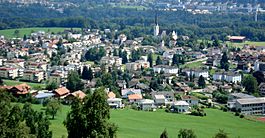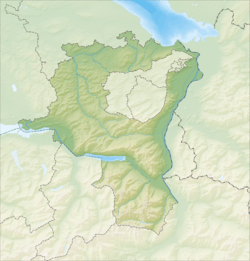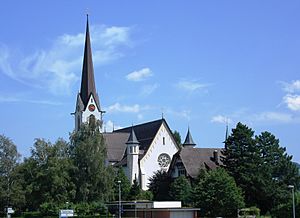Gaiserwald facts for kids
Quick facts for kids
Gaiserwald
|
||
|---|---|---|
 |
||
|
||
| Country | Switzerland | |
| Canton | St. Gallen | |
| District | St. Gallen | |
| Area | ||
| • Total | 12.63 km2 (4.88 sq mi) | |
| Elevation | 650 m (2,130 ft) | |
| Population
(Dec 2020 )
|
||
| • Total | 8,389 | |
| • Density | 664.21/km2 (1,720.3/sq mi) | |
| Postal code |
9030
|
|
| Surrounded by | Andwil, Gossau, St. Gallen, Waldkirch, Wittenbach | |
Gaiserwald is a municipality located in the canton of St. Gallen in Switzerland. It's part of the St. Gallen area. This municipality doesn't have a main village called Gaiserwald. Instead, it's made up of three smaller villages: St. Josefen, Abtwil, and Engelburg.
Contents
A Look at Gaiserwald's Past
Gaiserwald was first mentioned in official records way back in 1282. Back then, it was known as Gaiserwalt. This shows that the area has a long history.
Exploring Gaiserwald's Geography
Gaiserwald covers an area of about 12.7 square kilometers (about 4.9 square miles). A large part of this land, almost 50%, is used for farming. Forests cover about 30% of the area.
Around 19% of the land has buildings or roads. The remaining small part, about 1%, includes rivers or lakes. Gaiserwald is located near the city of St. Gallen and is considered one of its suburbs.
Understanding the Coat of Arms
The blazon (official description) of Gaiserwald's coat of arms is quite detailed. It shows a silver shield with a wavy blue stripe down the middle. On one side of the stripe, there are three red rings stacked vertically. On the other side, there's a red pine tree with its roots showing.
Who Lives in Gaiserwald?
Gaiserwald has a population of around 8,000 people. As of 2007, about 12% of the people living here were from other countries. Many of these foreign residents came from Germany, Italy, and former Yugoslavia.
Languages Spoken in Gaiserwald
Most people in Gaiserwald speak German, which is one of Switzerland's national languages. About 93% of the population speaks German. Other languages spoken include Serbo-Croatian and Albanian.
Age Groups in Gaiserwald
The population of Gaiserwald includes people of all ages. In 2000, about 11.8% of the population were children aged 0-9 years old. Teenagers (10-19 years old) made up about 15.6%. Adults aged 20-59 made up a large portion of the population. Senior citizens (60-99 years old) accounted for about 15.5% of the population.
Education Levels in Gaiserwald
People in Switzerland are generally well-educated. In Gaiserwald, about 79% of adults aged 25–64 have completed higher education. This means they finished either upper secondary school or went on to a university or a specialized college (a Fachhochschule).
Historical Population Growth
The population of Gaiserwald has changed a lot over the years. Here's how it has grown:
| year | population |
|---|---|
| 1850 | 1,269 |
| 1900 | 2,508 |
| 1941 | 2,173 |
| 1950 | 2,396 |
| 1960 | 2,319 |
| 2000 | 7,495 |
Important Buildings: Heritage Sites
The Catholic parish church of St. Josef is a very important building in Gaiserwald. It is listed as a Swiss heritage site of national significance. This means it's a special place that is protected for its historical and cultural value. The church was built between 1904 and 1905 in a gothic revival style by August Hardegger.
Gaiserwald's Economy
Gaiserwald has a healthy economy with various types of jobs. As of 2005, there were businesses in three main sectors:
- Primary sector: This includes jobs like farming. About 124 people worked in this area.
- Secondary sector: This involves manufacturing and industry. Around 427 people worked in this sector.
- Tertiary sector: This covers services, like shops, offices, and healthcare. About 1,229 people were employed in this sector.
Many residents of Gaiserwald also travel to other places for work. In 2000, over 3,000 residents worked outside the municipality. At the same time, nearly 1,000 people came into Gaiserwald for their jobs.
Religious Life in Gaiserwald
According to the 2000 census, most people in Gaiserwald are Christian. About 50% of the population are Roman Catholic. Another 33% belong to the Swiss Reformed Church.
There are also smaller groups of people who belong to other Christian churches, including the Orthodox Church. A small number of people are Islamic. About 6.5% of the population stated they had no religious affiliation.
See also
 In Spanish: Gaiserwald para niños
In Spanish: Gaiserwald para niños






